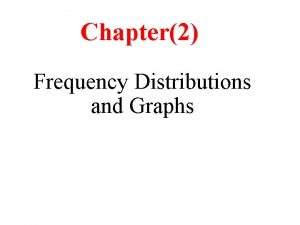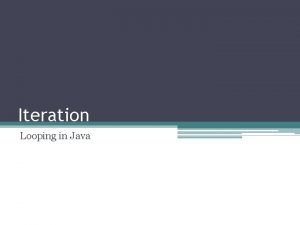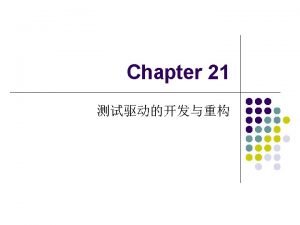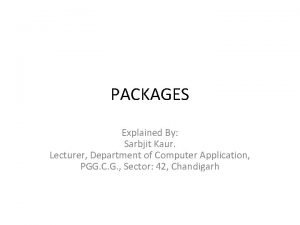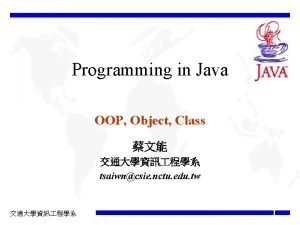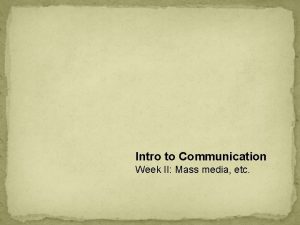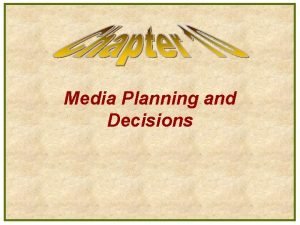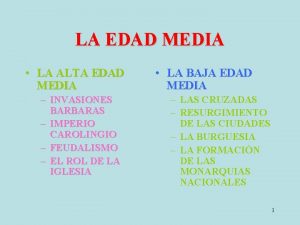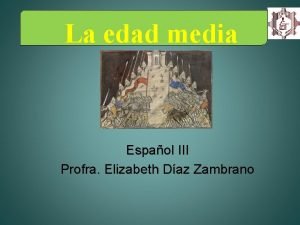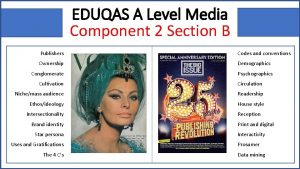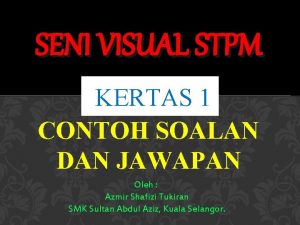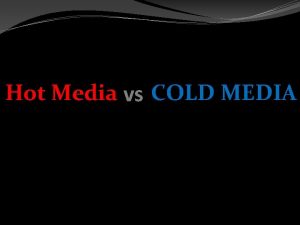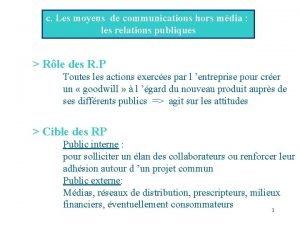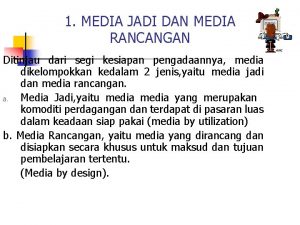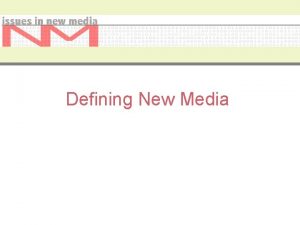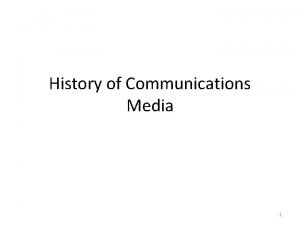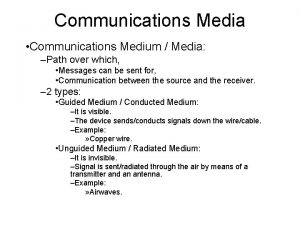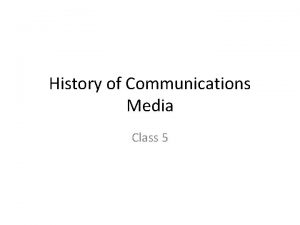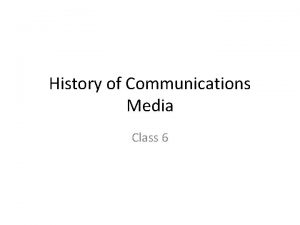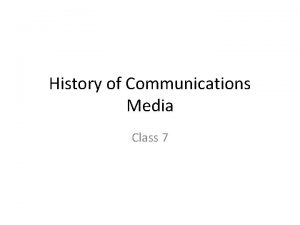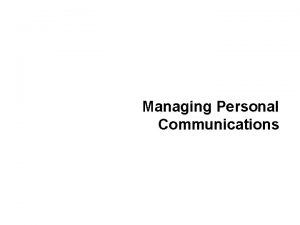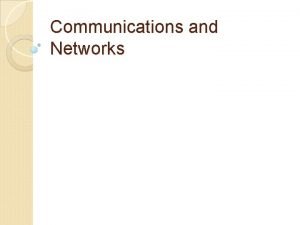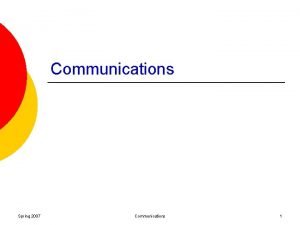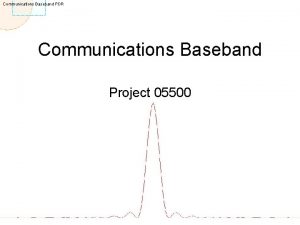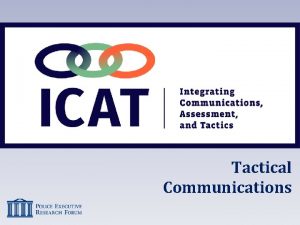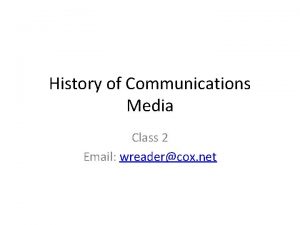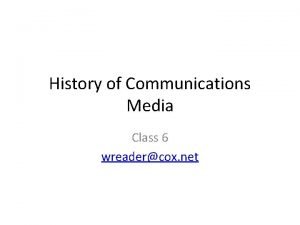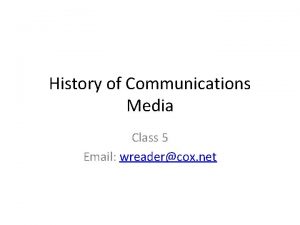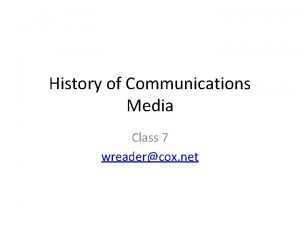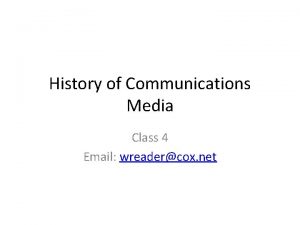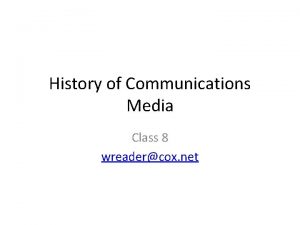History of Communications Media Class 2 History of






































- Slides: 38

History of Communications Media Class 2

History of Communications Media • Today’s Class – Manuscript Cultures – The Impact of Printing 2

History of Communications Media • Manuscript cultures – A high literate culture and a low village culture – Texts tended to be read aloud even to those who could read – Letters and documents were quasi-public – Writing served as input into the oral world – Manuscripts had incipits and chapter/verse designations rather than titles or page numbers 3

History of Communications Media • Manuscript cultures – 2 – Books are treasured items – The manuscript book had interesting corollaries – Word separation and punctuation of text did not become standard until the later Middle Ages – The sermon and public readings served as news dissemination media – What was ancient was venerated 4

Printing – Johann Gutenberg of Mainz was a German goldsmith and printer who was the first European to use movable type printing, in around 1439, and the global inventor of the mechanical printing press. – After printing several books, he started printing his famous Gutenberg Bible in 1455 • About 180 of these Bibles were printed • The Gutenberg Bible could best be described as a printed manuscript rather than a printed book

Printing • Gutenberg’s printing press depended on 3 innovations which he combined – Movable type cast in metal – Oil-based ink – Wooden press

Printing • Printing spread very rapidly – By 1480, 110 towns had printing presses – By 1500, 236 towns had print shops • It greatly multiplied the number of books and titles – Before Gutenberg, there were an estimated 30, 000 manuscript books in Europe – By 1500, there were more than 20 million books in 35, 000 titles

Printing • Some Notes about Printing - 1 – Printing involved not only text but also images, maps, diagrams, and data tables – Economics of printing – high upfront costs combined with relatively small marginal costs for each additional item • This contrasted sharply with the economics of manuscript production where upfront costs were low but marginal costs were extremely high

Printing • Some Notes about Printing – 2 – Effects of printing took a long time to show their effects – Out of printing emerged not only the printed book, but also the: • • • Broadside Pamphlet Leaflet Newspaper Scholarly Journal Poster Magazine Cartoon Comic Strip

Printing • The Printing Revolution had a host of effects, all stemming from the fact that Print: – Made possible the mass production of books and other printed material – Drastically lowered the cost of reproducing information – Produced typographical fixity

Printing • Some effects of lower costs: – Reduced books from a status symbol of wealth to a mere commodity – Made the monastic scriptoria and the university scriveners obsolete • Reduced the economic importance of the monasteries – Made it economically feasible to publish books in the vernacular languages as well as Latin

Printing • Intellectual effects of the Print Revolution – Made Possible a vast expansion of knowledge. It did this in the following ways: • Re-arranging the arts and routines of book-making in a way that brought printers, intellectuals, merchants, and workers into contact with each other • Revealed the knowledge deficits and errors in ancient texts • Permitted scholars to improve and correct their works in subsequent editions • Created print shops that were meeting places and message centers for scholars

Printing • Intellectual Effects of the Print Revolution – 2 – By making possible a vast expansion of knowledge, printing changed the concept of knowledge • It changed knowledge from the notion of a closed body of knowledge passed down generation to a concept of knowledge as the result of an open-ended investigatory process pressing against ever-advancing frontiers

Printing • The Print Revolution – 1 – Created a ‘reading public’ – Fostered privacy and isolation • • Reading demands quiet and freedom from distraction Print set the stage psychologically for solo reading Replaced aural reading with silent reading Printed books permitted people to escape from the outside world

Printing • The Print Revolution – 2 – Made possible the creation of identical images, maps, diagrams, charts, and numerical tables • This fostered the development of science • It permitted copies of art works to be seen by people who would never visit the site where the original artwork was located • It led to the mass printing of playing cards and religious images

Printing • The Print Revolution – 3 – Made possible the creation of more accurate maps • Printing made possible an era of feedback from map users to mapmakers • It also prevented the degradation that results over successive generations of a map

Printing • The Print Revolution – 4 – Made possible the creation of illustrated books • This was a boon to science, technology, and engineering – The creation of illustrated books and other illustrated material • Made celebrities out of authors and people who were the subject of a book • Enabled rulers to impress their personal image on their subjects

Printing • The Print Revolution – 5 – Created private ownership of knowledge – This led to: • The concept of the author • Resentment of plagiarism • Copyright laws – Copyright laws led to the practice of authors selling their manuscripts to publishers

Printing • The Print Revolution – 6 – Extended the power of monarchs and bureaucrats • As noted before, prints and engravers made it possible for rulers to make his facial image and physical features known to his subjects • Monarchs were quick to use print to convey information to their subjects and to affect the attitudes of their subjects

Printing • The Print Revolution – 7 – Led to the institution of censorship • Political & religious leaders were quick to see the power of print. This led them to: – Require printers to be licensed – Restricting the number of printers in the realm – Censorship » Banning of radical, heretical, pornographic, and libelous books – Censorship in turn led to attempts at evasion, such as smuggling of banned books into countries that banned them

Printing • Language Effects of the Print Revolution - 1 – Affected both Latin and the vernacular languages of Europe • As noted earlier, printing made it profitable to publish books in vernacular languages as well as in Latin – This raised the status of vernacular languages such as English, French, and German by giving them a literary status equal to that of Latin – This contributed to the slow decline of Latin as a European elite lingua franca

Printing • Language Effects of the Print Revolution -2 – Whether or not there was a printed Bible in the language determined whether the language became permanent or became a mere provincial dialect – Printing contributed to the homogenization of many regional dialects into a few national languages

Printing • Language effects of the Print Revolution - 3 – Printing led to standardized grammar and spelling • This in turn led to notions of ‘correctness’ in language • The idea of using correct language in turn led to mass publication of dictionaries – Printing replaced poetry with prose

Printing • What Print does that the Manuscript does not – Print permitted externalization of our memories – Print made the Bible a single book rather than a collection of discrete mss known as the Scriptures – Print fostered a linear, rational, sequential way of thinking

Printing • What Print does that the Manuscript does not -2 – Print permitted pagination; Mss were organized by chapter and verse – Pagination led to page numbers, indexes, crossreferences, and table of contents – all lacking in manuscripts – Print led to title pages; Mss were labeled by their incipits

Printing • What Print does that the Manuscript does not – 3 – Print led to the concept of the book as a logical unit – Print changed the document focus from that of the producer/copyist to that of the reader – Print encouraged a sense of closure and finality – the idea that the represents the author’s words in a definitive or final form

Printing • Significant Social and Historical Effects – Print was a major factor in the development of the following: • • • Capitalism The Protestant Reformation Nationalism Intellectual Liberalism The creation of childhood as a distinct social category • I will discuss each in turn

Printing • Printing and the Development of Capitalism – Printing shops were the first major urban capitalist enterprises • Print shop economics – large up-front costs combined with later revenues • The print shop’s demand for paper stimulated the growth of the paper manufacturing industry which led it to rationalize the collection of rags • Printing press technology anticipated many features of industrial production

Printing • Printing and the Protestant Reformation – When Luther nailed his Ninety-Five Theses to the church door, he saw it as merely an invitation to an academic disputation – Protestantism was the first religious movement to fully exploit printing’s potential as a mass medium • Luther described printing as “God’s highest and extremist act of grace, whereby the business of the gospel is driven forward. ”

Printing • Printing and the Protestant Reformation - 2 – Printing brought into focus many troublesome issues that had been easily glossed over before • One issue was the relation of Scripture and Tradition • Another was the relationship of faith and works – Printing with its focus on the word of God led to simpler forms of church architecture • Art was banished from the churches – compare the Gothic cathedral with the Old South Church

Printing • Printing and the Protestant Reformation - 3 – Popular editions of the Bible (such as the Luther & King James versions) had some interesting results: • They led people to draw an inevitable contrast between the idealized origin Church depicted in Acts and its current reality – Led many to see the present as a corruption and a decline from the past • Contrary to the intentions of the Reformers, it led to the fracturing of Protestantism

Printing • The Book of Scripture or the Book of Nature – both were seen as the handiwork of God – Printing had a differential impact on the study of both: • Biblical scholarship could not get back to the pure original words of God before they had been corrupted by copyists over time • The study of nature, however, could progress as corrupted scientific data could be compared with, and corrected by, current observations and experiments

Printing • But if the Book of Nature (what science revealed) seemed to contradict the Book of Scripture (what God revealed), then what: – For intellectuals and members of the educated elite, the logical conclusion was that the Book revealed by science was true and that the Bible was simply a collection of legends – For common believers, the logical conclusion was that Scripture was an infallible source of scientific knowledge

Printing • Printing and the Rise of Nationalism – Printing fostered the idea of being part of largescale collective groups – Printing, as noted earlier, elevated the status of the vernacular language, thus fostering a sense of ethnic-linguistic nationalism – Printing created walls between different language groups while homogenizing differences within – Print media proved very useful in arousing nationalist feelings and hatreds

Printing • Printing and Intellectual Liberalism – Printers disliked censorship • They were natural libertarians who generally wanted the freedom to print whatever they wanted and whatever they thought would sell – Printers had to deal with scholars and intellectuals • This in itself contributed to liberal attitudes since intellectual pursuits brought together people from very diverse backgrounds and from different religions

Printing • Printing and Childhood – Printing created childhood as a distinct social category • In the centuries after the invention of printing, Adulthood was redefined – one became an adult by learning how to read • Before the printing press, children became adults by learning to speak – a behavior for which all humans are hardwired and which they generally master by age 7 – Thus the Catholic Church and the Law both defined age 7 as the age of reason and the age at which they became morally and legally responsible for their actions

Printing • Printing and Childhood – 2 • After printing, children had to earn adulthood by becoming literate, for which people are not hardwired – This meant children had to go to school – With the establishment of schools, children came to be viewed as a special class of people different from adults • People began to see human development as a series of stages, with childhood being a bridge between infancy and adulthood – Before print, children were seen as little adults and seen as part of the adult world

Printing • As noted before, printing led to new formats and genres of literature: – Early genres included the book, broadside, and pamphlet – The mid-17 th century saw the newspaper – The late-17 th –early-18 th centuries saw the scholarly journal – The 19 th century saw the daily newspaper and the magazine
 Perform voice communications army powerpoint
Perform voice communications army powerpoint Today is class
Today is class Putting a package together
Putting a package together Difference between abstract class and concrete class
Difference between abstract class and concrete class Measures of central tendency for grouped data
Measures of central tendency for grouped data Class i vs class ii mhc
Class i vs class ii mhc Abstract concrete class relationship
Abstract concrete class relationship Class size of class interval
Class size of class interval Stimuli vs stimulus
Stimuli vs stimulus Discriminative stimulus
Discriminative stimulus Therapeutic class and pharmacologic class
Therapeutic class and pharmacologic class Class maths student student1 class student string name
Class maths student student1 class student string name How to find class boundaries
How to find class boundaries In greenfoot, you can cast an actor class to a world class?
In greenfoot, you can cast an actor class to a world class? Static vs dynamic class loading in java
Static vs dynamic class loading in java Esd class 0
Esd class 0 Class diagram static class
Class diagram static class Class 2 class 3
Class 2 class 3 Public class test subject extends test class
Public class test subject extends test class Package mypackage class first class body
Package mypackage class first class body Class third class
Class third class Protected in uml
Protected in uml Component class has composite class as collaborator
Component class has composite class as collaborator Class-dominant theory examples
Class-dominant theory examples Msa agar selective or differential
Msa agar selective or differential Perbedaan media jadi dan media rancang
Perbedaan media jadi dan media rancang Decision media
Decision media Differentiate people as media and people in media
Differentiate people as media and people in media Alta edad media y baja edad media
Alta edad media y baja edad media Edad media características
Edad media características Hot and cold medium
Hot and cold medium Staphylococcus aureus eosin methylene blue agar
Staphylococcus aureus eosin methylene blue agar A level media vogue analysis
A level media vogue analysis Maksud media komunikasi visual
Maksud media komunikasi visual Hot media and cold media
Hot media and cold media Moyens médias et hors médias
Moyens médias et hors médias Benefits of transferring data over a wired network
Benefits of transferring data over a wired network Perbedaan media jadi dan media rancang
Perbedaan media jadi dan media rancang Hot and cold media
Hot and cold media












